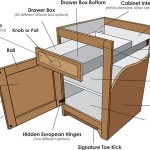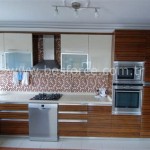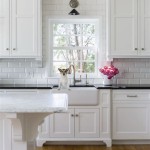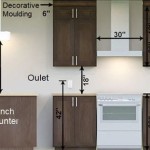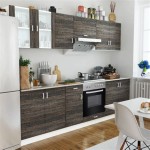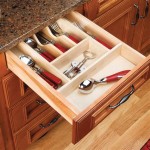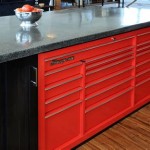Kitchen Cabinets: Beadboard Doors and Trim
Kitchen design is a multifaceted process, involving the selection of materials, styles, and layouts that harmonize to create a functional and aesthetically pleasing space. Among the diverse elements contributing to kitchen aesthetics, cabinetry stands out as a particularly impactful feature. The choice of cabinet doors and trim plays a pivotal role in defining the overall character of the kitchen, and beadboard has emerged as a popular choice for those seeking a blend of classic charm and textural interest.
Beadboard, also sometimes referred to as wainscoting when used on walls, is a series of vertical, parallel planks joined together with a distinctive beaded edge. This beaded detail creates a subtle, rhythmic texture that adds depth and visual appeal to surfaces. In the context of kitchen cabinetry, beadboard is frequently incorporated into door panels and trim elements, introducing a touch of traditional elegance and rustic warmth. The versatility of beadboard allows it to be seamlessly integrated into a variety of kitchen designs, from farmhouse and cottage styles to more transitional and even contemporary settings, depending on the specific execution and accompanying design elements.
The use of beadboard in kitchen cabinets extends beyond mere aesthetics. It offers a practical solution for concealing imperfections in cabinet surfaces, adding structural reinforcement, and providing a durable, easy-to-clean finish. The inherent texture of beadboard also contributes to improved sound absorption, reducing echoes and creating a more comfortable and acoustically balanced kitchen environment. The enduring popularity of beadboard stems from its ability to combine visual appeal with functional benefits, making it a valuable addition to any kitchen design.
Aesthetic Versatility and Style Integration
The aesthetic versatility of beadboard is a significant factor in its widespread adoption within kitchen design. It can be seamlessly integrated into a variety of styles, adapting to the overall design language of the space. In farmhouse and cottage-style kitchens, beadboard doors and trim evoke a sense of rustic charm and nostalgia, complementing other traditional elements such as apron-front sinks, open shelving, and exposed beams. The use of paint colors like creamy whites, soft greys, and muted blues further reinforces the farmhouse aesthetic, creating a warm and inviting atmosphere.
For transitional kitchens, beadboard can be used to bridge the gap between traditional and modern styles. Pairing beadboard doors with sleek, contemporary hardware and clean-lined countertops creates a balanced and sophisticated look. Neutral color palettes, such as off-whites, taupes, and light greys, allow the beadboard detail to stand out without overwhelming the space. The incorporation of modern lighting fixtures and appliances further contributes to the transitional aesthetic.
Even in contemporary kitchens, beadboard can be incorporated in unexpected ways to add textural interest and visual depth. Using beadboard as an accent detail, such as on a kitchen island or as a backsplash, can introduce a subtle touch of classic charm without compromising the overall modern aesthetic. When used in a contemporary setting, beadboard is often painted in bold, contrasting colors or paired with high-gloss finishes to create a striking visual impact. The key to successfully integrating beadboard into contemporary design is to use it sparingly and strategically, allowing it to serve as a focal point rather than a dominant element.
The choice of beadboard profile also influences its overall aesthetic impact. Wider beadboard panels create a more rustic and relaxed feel, while narrower panels offer a more refined and elegant look. The spacing between the beads also affects the visual texture, with closer spacing creating a more subtle and delicate effect. Considering the specific characteristics of the beadboard profile is essential for achieving the desired aesthetic within the kitchen design.
Material Considerations and Durability
The choice of materials for beadboard cabinet doors and trim is crucial for ensuring durability and longevity. Solid wood beadboard offers the most authentic look and feel, as well as superior durability and resistance to moisture. However, solid wood can be more expensive and may be prone to warping or cracking in environments with high humidity fluctuations. Common wood species used for beadboard include maple, oak, cherry, and pine, each offering its unique grain patterns and aesthetic qualities.
An alternative to solid wood is medium-density fiberboard (MDF) beadboard. MDF is a composite material made from wood fibers and resin, offering a stable and consistent surface that is less prone to warping or cracking than solid wood. MDF is also more affordable than solid wood and can be easily painted or finished to achieve the desired look. However, MDF is not as resistant to moisture as solid wood and should be properly sealed and protected from water damage.
For kitchens in high-moisture environments, such as coastal areas or those prone to leaks, moisture-resistant MDF (MR MDF) is a suitable option. MR MDF is specifically formulated to withstand moisture and resist swelling or delamination. While more expensive than standard MDF, MR MDF offers enhanced durability and longevity in challenging environments.
The finish applied to beadboard cabinet doors and trim also plays a crucial role in protecting the material and enhancing its aesthetic appeal. Paint is a common choice for beadboard, offering a wide range of colors and finishes to match the overall kitchen design. A high-quality primer and sealant are essential for ensuring proper adhesion and preventing moisture penetration. Alternatively, a clear coat of varnish or polyurethane can be applied to protect the natural wood grain and provide a durable, easy-to-clean surface.
Installation and Maintenance
Proper installation is essential for ensuring the longevity and performance of beadboard cabinet doors and trim. Professional installation is recommended, particularly for complex installations or those requiring precise measurements and cuts. However, experienced DIYers can undertake the installation process with careful planning and attention to detail.
Before installing beadboard, it is important to ensure that the underlying surfaces are clean, smooth, and level. Any imperfections or irregularities should be addressed before proceeding with the installation. The beadboard should be properly acclimated to the kitchen environment for several days before installation to allow it to adjust to the temperature and humidity levels. This helps to prevent warping or cracking after installation.
When installing beadboard doors, it is essential to use high-quality hinges and hardware that are appropriate for the weight and size of the doors. Proper alignment and spacing are crucial for ensuring smooth operation and preventing sagging or misalignment. The trim should be securely fastened to the cabinet frames using nails, screws, or adhesive, ensuring a tight and seamless fit.
Maintaining beadboard cabinet doors and trim is relatively straightforward. Regular cleaning with a mild soap and water solution is typically sufficient for removing dirt and grime. Avoid using harsh chemicals or abrasive cleaners, as these can damage the finish. Any spills or stains should be cleaned up promptly to prevent permanent discoloration. Periodically inspecting the beadboard for signs of damage, such as cracks, chips, or peeling paint, is essential for identifying and addressing issues before they escalate.
Touching up scratches or chips with matching paint or stain can help to maintain the aesthetic appearance of the beadboard and prevent further damage. In high-moisture environments, it may be necessary to apply a sealant or varnish periodically to protect the beadboard from moisture damage. With proper care and maintenance, beadboard cabinet doors and trim can retain their beauty and functionality for years to come.
Ultimately, the decision to incorporate beadboard into kitchen cabinets is a matter of personal preference and design goals. However, the aesthetic versatility, durability, and ease of maintenance of beadboard make it a compelling option for those seeking to add a touch of classic charm and textural interest to their kitchen design.

Custom Made A D J E C T I V Beadboard P L O N Cherry Cabinet Doors Estate Millwork

Beadboard Cabinets Guide Stunning Styles For Your Home

Black Paneled Cabinets With Beadboard Trim Transitional Kitchen

Beadboard Cabinets Guide Stunning Styles For Your Home

Beadboard Cabinets Guide Stunning Styles For Your Home

Beadboard Cabinets Guide Stunning Styles For Your Home

Beadboard Kitchen Cabinet Trim Design Ideas

9 Ideas For Kitchen Cabinet Doors Cabinetdoors Com

How To Use Beadboard Cabinets Fast Cabinet Doors

Cabinets With Beadboard Backs Design Ideas
Related Posts

